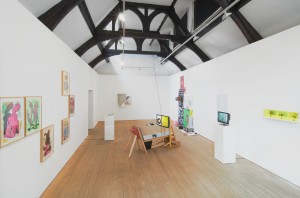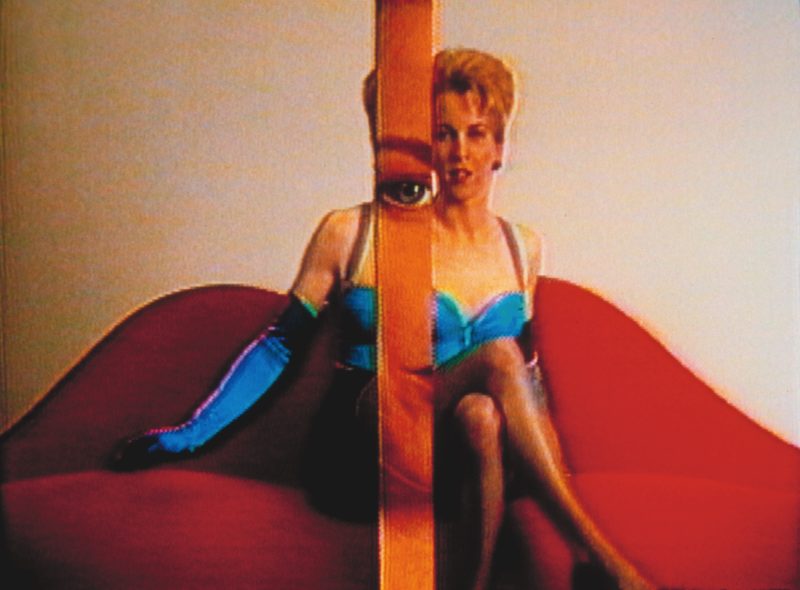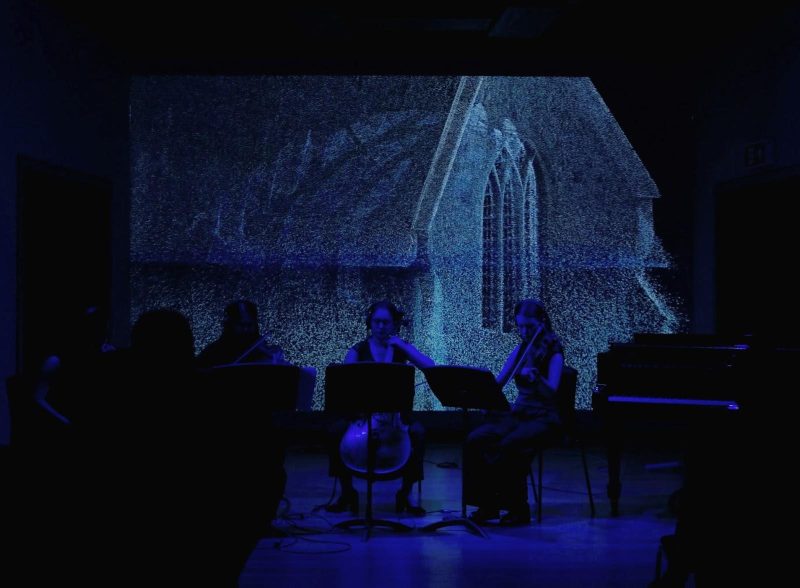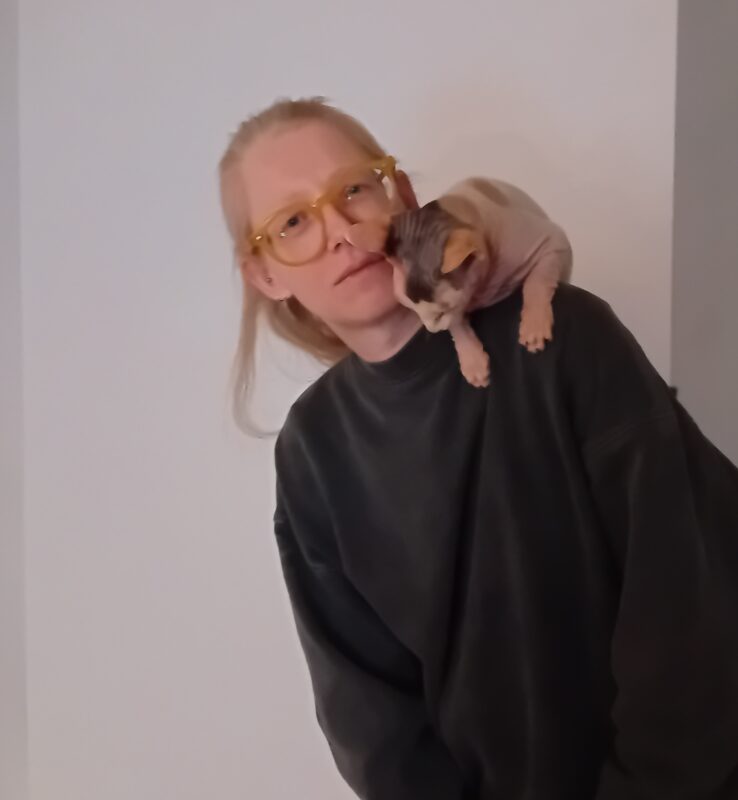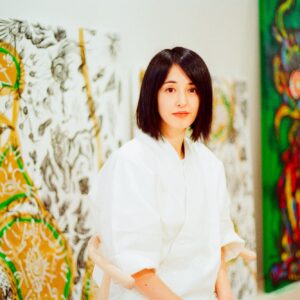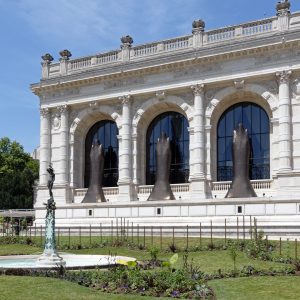Yvette Greslé talks to Rebecca Lennon about ‘Fresh Trauma’, the exhibition she’s curated at Ceri Hand gallery www.cerihand.co.uk. The show runs through to 29 June 2013. Artists exhibited are Gabriele Beveridge, Edwin Burdis, Benedict Drew, Angus Fairhurst, Rebecca Lennon, Choc Ly Tan, Shana Moulton and Heather Phillipson.
Lennon (b.1981) graduated from the MA Fine Art at Slade (University College London) in 2010. Her work incorporating sound, video, collage, texts, props and live performance has appeared on a number of solo and group exhibitions, and screenings both in the UK and abroad. She is represented by Ceri Hand gallery.
Exhibitions curated by artists open up interesting questions about the relationship between art and curating. The proximity that artists have to the process of making work situate them in a potentially rich relationship to curating. Curating is, of course, not simply about the placement of art within an exhibition space: it is a critical and creative practice that thinks about art’s dialogue with ideas, and visual languages, space, architecture, light and sound. Visual images and sounds function in relation to intangible worlds and experiences shaped by affects, emotions and senses. It is this that is most interesting about ‘Fresh Trauma’, and Lennon’s role as both artist and curator. Amongst videos, objects, and installations and mixed media works by a generation of artists all born in the late 1970s and early ‘80s, is a work by Angus Fairhurst (1966-2008). His ‘Cheap and Ill-Fitting Gorilla Suit’ (1995) is a poignant and critical presence placed amongst the work of a younger generation who consider him influential. ‘Fresh Trauma’ speaks to 21st century art practices in dialogue with the past while searching for a language of the present: works on show – poetic, absurd and affecting – resist the simple telling of a story.
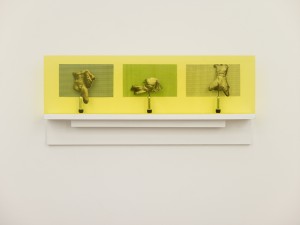 Rebecca Lennon. ‘Dark Matter’, 2013. Perspex, financial envelopes, wooden shelf, vibrators, headless cut-out prints.
Rebecca Lennon. ‘Dark Matter’, 2013. Perspex, financial envelopes, wooden shelf, vibrators, headless cut-out prints.
What are the ideas that drive this show?
I’m interested in the physicality of a lot of artist’s work and in recurring motifs: the sensory displacement of smells, of senses, of visual and morphing forms. There is a sense of abstraction and at the same time something that speaks quite loud. I started looking at artists that I was interested in, and I brought the show together around those ideas. I realised that inevitably as an artist you bring ideas together in relation to your ideas.
I think the artists on this show work differently. But a common thread running through the exhibition is to do with ideas about sensory displacement, displacement in general. There’s a kind of erasure or abstraction of the body. There’s a morphing of the body. There’s a sense of precariousness and reduction but in a meaningful, slightly funny way. In Edwin Burdis’ work there are all these body shapes: there’s an abstraction to his images, while you can work out things about them that are recognisable. There’s disguise and costume. There’s also a sense of relating that’s performative.
I don’t think any of the artists can be reduced to this idea of ‘Fresh Trauma’. It’s more about the idea of curating a show of artists that I really love, and I tried to have a title and concept for the show that is very physical and about a sensory relation to our time: in that way all the artists connect.
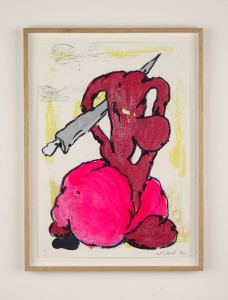 Edwin Burdis, ‘Back Sack and Crack 7’, 2010. Wax crayon and poster paints on paper.
Edwin Burdis, ‘Back Sack and Crack 7’, 2010. Wax crayon and poster paints on paper.
Why did you go with this word trauma?
It came from a really abstract idea I had about the way that trauma functions in the mind. I was thinking about the idea that when you have memories apparently the mind organises memories (traumatic memories) into patterns of shapes. These trauma memories or events often re-cur on loop.
It’s interesting to think about traumatic memory: the muddling up of memories, the collapsing of time, the perpetual return to the point of trauma. As an artist the material aspect of trauma relates to looping – this is often played out literally in video work?
Yes. I’m interested in the idea of looping and the idea of the sensory, evocative element of the memories that are looping.
The work on show is also very tactile, very physical. I can see it so powerfully in Benedict Drew’s work: in the materials he uses.
I think this is where art critique breaks down. That’s what’s interesting about it for me. A lot of the artwork in the show is quite different but there is something very physical about a lot of the work. There is a visceral and sensory element to the work.
 Benedict Drew, ‘Apoplectic’, 2013. Mixed media.
Benedict Drew, ‘Apoplectic’, 2013. Mixed media.
The work is very affecting and very sensory. I find myself responding to it emotionally, and it’s very difficult to find a language to speak about the work. Perhaps there’s something important about it for the present but we don’t yet fully understand it, or have a language for it.
I think that’s interesting. I was asked before about the relationship between ideas and abstraction. I think it’s about that as well. There’s a conceptual dimension to the idea of senses. Benedict Drew’s work is very interesting because he’s taken things like plastic bags that he casts (the insides of the plastic bags are cast and then go mouldy). And then they’re rendered in digital prints. There are all these blobs, and Princess Diana looping trying to look three-dimensional but not quite making it. This idea that ‘one day all your things will answer back’.
Benedict’s altar comes out of a website he created?
Yes, he tried to create it in analogue form and it was a failure in the way that it was created. It reminds me of protest displays. It also makes me think of the precarious homages you get to celebrities that die – Michael Jackson or Amy Winehouse.
It looks like all the mess of the 21st century – all the stuff and clutter: from television culture to all the technological waste. What happens to all the stuff from the twentieth century: all that plastic, all that redundant technology? You can’t make cohesive connections between all the things on Benedict’s altar and that’s really fascinating.
I think for him it’s about an oppressive force. It’s a critique of an oppressive, faceless force in our world: the economy of the market and bureaucracy.
He’s made a lot of video and sound installations with some kind of physical element to it. With this he wanted to do something in real space. I was talking to him about my ideas for the show and he showed me this website (this work comes out of this). It’s quite different from the work on the show, but it uses a lot of the same elements.
 Gabriele Beveridge, ‘Mostly that your face is like the sky behind the Holiday Inn’, 2013. Steel, dusty window blinds, hand-made glass, sand, printed advertisement, broken wine glass, artist frame.
Gabriele Beveridge, ‘Mostly that your face is like the sky behind the Holiday Inn’, 2013. Steel, dusty window blinds, hand-made glass, sand, printed advertisement, broken wine glass, artist frame.
Gabriele Beveridge’s work is also interesting in terms of the materials she uses: the dusty window blind, the sand.
There’s a sensory use of materials. She often uses things that are artificial. The photograph is taken from a hairdresser’s window, and it’s faded by the sun. Inside the frame is sand and you’re looking through a dirty blind and there’s broken glass. The use of materials is really important to her: she uses marbled glass that you get in hotels. She’s playing with artificiality and seduction in quite an interesting way.
Why did you choose to place Angus Fairhurst’s ‘Cheap and Ill-Fitting Gorilla Suit’ in the show?
Angus Fairhurst is actually one of my favourite artists. The action he performs is a very simple conceptual gesture: a performative gesture. It’s a very iconic work for artists of my age in a way. The YBA’s were around when we were just developing. He’s wearing this gorilla costume and then ripping it off to reveal just a naked and quite vulnerable human body underneath. There’s a kind of slapstick element to it but there’s also something quite meaningful: there’s the idea of costume. For me it’s about the human body reduced to an abstract shape and in that way it links to a lot of the other artists on the show and also to the way I’m thinking in general. I think the gorilla is a very complex image in Angus Fairhurst’s work. It’s very simple but at the same time it’s very complex: it’s about our relationship to nature, and our relationship to a world before our time (something that we romantically identify with), the idea of being human, being animal. At the same time he doesn’t start being a gorilla: he’s wearing a gorilla costume. There’s a kind of act to it. There’s a violence but a comical violence.
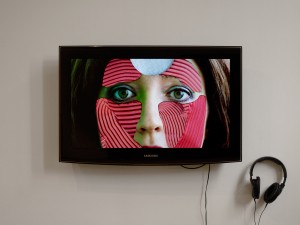 Shana Moulton, ‘Swisspering Pines’, 2013. HD-single channel video.
Shana Moulton, ‘Swisspering Pines’, 2013. HD-single channel video.
What do you think about humour in the show?
Humour is a hard one because I think it depends on your sense of humour. I find humour very difficult. I don’t often watch comedies because I don’t find them funny. Shana Moulton’s work is very interesting. She’s made a whole series of videos called ‘Whispering Pines’. She’s created a character called Cynthia, which I think is based on her. She often uses motifs from our lives: these tacky motifs that are floating around in these worlds that she creates. They are often motifs that are associated with the New Age desire for spirituality through objects. In this work – ‘Swisspering Pines’ – she removes her face with make-up remover and reveals what looks like plasticine underneath. There’s a humour to it but it’s also about surface and the way that we interact with objects in our lives.
There’s also a sense of disassociation about Shana Moulton’s work: a sense of something that is very mundane and banal.
She was apparently very influenced by David Lynch’s ‘Twin Peaks’ which I was very influenced by when I was growing up. In some other pieces she’s directly referencing ‘Twin Peaks’: which has this sense of something that is mundane, but surreal at the same time.
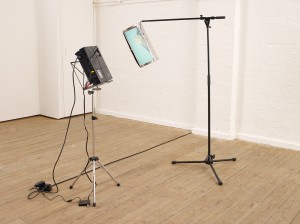 Chooc Ly Tan, ‘Not Such a Hasty Hush Boom’, 2013. Music Stand, video projection, boom microphone stand, bread bin, paper.
Chooc Ly Tan, ‘Not Such a Hasty Hush Boom’, 2013. Music Stand, video projection, boom microphone stand, bread bin, paper.
Chooc Ly Tan’s work is really poetic and affecting.
Often there’s a pseudo-scientific element to her work. Her use of objects is very interesting. There’s a precarious-ness to the bread-bin hanging from a mike stand. I really like the idea of the volcanic eruption – something we can’t quite comprehend – being contained within a bread bin hanging from a mike stand, and reduced to a projection.
What do you think is interesting about being an artist and a curator?
I don’t see myself as a curator. I see myself as an artist.
‘Fresh Trauma’: Ceri Hand gallery, 6 Copperfield Street, London SE1 0EP (Tuesday-Saturday 10am – 6pm during exhibitions or by appointment). Until 29 June 2013 www.cerihand.co.uk
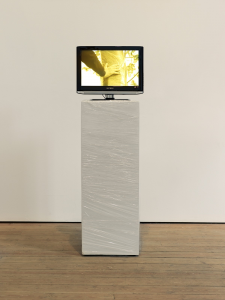 Rebecca Lennon, ‘Fresh Trauma’, 2013, HD video, 4 minutes, 11 seconds.
Rebecca Lennon, ‘Fresh Trauma’, 2013, HD video, 4 minutes, 11 seconds.
